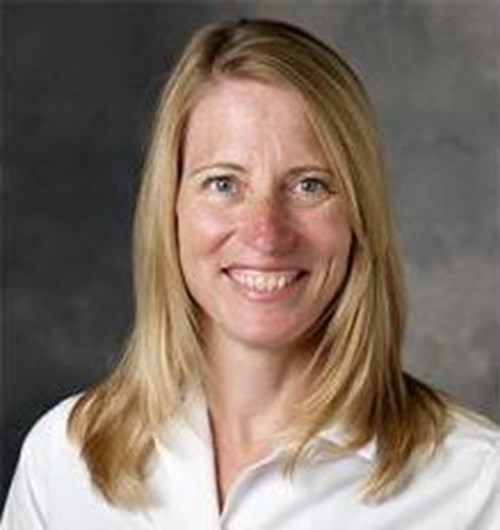The Current Treatment Landscape for Relapsed/Refractory Multiple Myeloma: A Case-Based Approach
Module 1: Medical Management of Patients with Relapsed/Refractory Multiple Myeloma
How would our panel members manage the treatment of a patient with relapsed/refractory multiple myeloma? Join them as they discuss a challenging case.
Chair

Rhonda Hewitt, MSN, ANP, AOCNP
Stanford Health Care
Faculty

Ann McNeill, RN, MSN, APN
John Theurer Cancer Center

Kevin Brigle, PhD, ANP
Virginia Commonwealth University, Massey Cancer Center
Transcript
Rhonda Hewitt: Welcome to this virtual round table on relapsed refractory multiple myeloma. My name is Rhonda Hewitt, and I'm a nurse practitioner at Stanford Health Care. Joining me today are two of my colleagues, Kevin and Anne, who will now introduce themselves.
Kevin Brigle: Thanks Rhonda. Hi, I'm Kevin Brigle. I'm a nurse practitioner in the heme-malignancy clinic at Virginia Commonwealth University Massey Cancer Center.
Anne McNeill: Hi, my name is Anne McNeill, and I'm a nurse practitioner in the multiple myeloma division at the John Theurer Cancer Center in Hackensack, New Jersey.
Rhonda Hewitt: So we will be discussing cases today. And our first patient is Robert. He's a 60-year-old male with IgG kappa multiple myeloma associated with renal insufficiency, low albumin, and anemia. Status post autologous stem cell transplant followed by carfilzomib, lenalidomide, and dexamethasone maintenance. And he's now on daratumumab pomalidomide and dexamethasone since March of 2018 for a biochemical relapse. And he presents today for routine follow up.
So Robert's past medical history is actually significant for asthma. That gave us a bit of a problem when we were treating him. He has a history of pneumococcal pneumonia. He has unexplained respiratory failure, which required intubation in November of 2015. And he's had multiple surgeries to his left arm, right shoulder, and his right leg.
His social history. He graduated from UCLA, where he played football, and he currently works full-time as a corporate lawyer in the San Jose area. He's also a college football commentator on ESPN. He lives with his wife of 30-plus years, and they have three grown children and a dog named Benito. And during the football season, he travels all over the country as he's a commentator. So he first developed mild thrombocytopenia in April of 2015, when a CBC showed a white blood cell count of 4.7, hemoglobin of 13.9, and a platelet count of 125. His serum protein at the time was mildly elevated at 8.4 with a total globulin of 4.6. And based on those labs, his primary care to doctor told him to follow up in 1 year. So a little bit longer than a year later he presents and he has new onset macrocytic anemia with renal insufficiency, low albumin, and elevated total serum protein and globulin at his visit with his primary care physician.
At the time his white blood cell count was normal. Hemoglobin was a little low at 9.9. Platelets were normal. His MCV was 104. Neutrophils were a little low at 1320. His creatinine was a little bit elevated at 1.65. His albumin was low at 2.7, and his total protein 13.2 with a globulin of 10.5. The serum protein electrophoresis showed the presence of an M spike. No immunofixation was done at that time. And he had serum light chain, which showed an elevated kappa light chain with an increased kappa-lambda ratio. Because of that, he was referred to hematology for a possible diagnosis of multiple myeloma. As bone marrow biopsy, a diagnostic bone marrow biopsy done in July of 2016, showed that he had 87% plasma cells and the cytogenetics of FISH were pending when he was referred to our institution. A skeletal survey showed no evidence of lytic disease, and his beta two microglobulin was elevated almost 5,000.
His LDH was 239 and his albumin, as I said, was low at 2.7. So the plan for Robert was actually to proceed with a fairly standard induction regimen, which includes lenalidomide bortezomib and dexamethasone. But because he was admitted at the hospital, there was a delay in getting the lenalidomide approved due to insurance authorization. So he actually started with just the bortezomib and the dexamethasone awaiting authorization for that lenalidomide. During that time, his M spike actually increased from 8.3 to 9.5. The cytogenetics of FISH returned revealing that he had a monosomy 11, a 1q+, and FISH and IGH rearrangement. So he was switched at that time in August of 2016, he was switched to carfilzomib lenalidomide and dexamethasone because he was considered to be a high-risk patient. And there was also the suggestion that his multiple myeloma may have been resistant to bortezomib. What do you think about that, guys?
Kevin Brigle: It sounds like he just had a cycle or so of the bortezomib and without the lenalidomide on board. I don't know that I would've been so quick to pull the trigger immediately on the original recommendation of the VRd for starters.
Rhonda Hewitt: Yeah.
Anne McNeill: Yeah. And now we're really doing a lot more carfilzomib than bortezomib, but this was a little bit in the past when it wasn't more common to use carfilzomib, but I agree with Kevin, I don't know if I would've immediately after one cycle switched from bortezomib to carfilzomib.
Rhonda Hewitt: Yeah, that was actually my question as well, and it was debated within our group as well. He was initially referred to us from an outside facility. So we got him when he was already on the carfilzomib lenalidomide and dexamethasone. So he went on to complete seven cycles of that carfilzomib lenalidomide dexamethasone, and then proceeded to autologous stem cell transplant in April of 2017. His repeat bone marrow biopsy 3 months after transplant showed that he had 5% plasma cells. His M spike had increased just a little bit after transplant. It was 0.9. It had increased up to 1.2. But as capital light chains were also going up, they were 34 post transplant up to 53. So there was concern that his disease was recurrent at that point in time.
So he actually started a higher dose of carfilzomib than he was receiving initially. So he restarted the carfilzomib at 56 mg/m2 in combination with lenalidomide and dexamethasone. He was maintained on that for about 4 months, and then his carfilzomib was switched to every other week dosing. His lenalidomide was tapered down, and his dexamethasone was also tapered down a little bit to 10 milligrams on just the carfilzomib days. And so in January of 2018, Robert developed neutropenia also noted to have some transient micro angiopathy.
And in March we see that he actually, his M spike increased to 1.9 and he was started on daratumumab pomalidomide and dexamethasone for what we considered to be a biochemical relapse. Can you tell me, Anne, a little bit about how you guys treat a biochemical relapse differently than you would a fluid relapse in multiple myeloma?
Anne McNeill: So it's interesting with this case with Robert, because I do agree with his algorithm of treatment, I guess, because he really clearly wasn't refractory to carfilzomib lenalidomide index. So going back to that regimen is probably a wise thing to do and increasing the dose appropriately. So we always, as you said with the case with Robert, always clearly flow and kind of really note those labs because obviously we want to catch a biochemical relapse prior to a clinical symptomatic relapse. So I think that, and in our institution, what we call DPd or daratumumab-pomalidomide-dexamethasone is clearly our first relapse go-to combination regimen. So if somebody has a more aggressive, ugly relapse, perhaps we would go for instead of a triplet, maybe a quadruple therapy, or maybe an inpatient regimen, something more aggressive. But I agree with the providers in this case on how they treated Robert, and that's how probably we would have dealt with his case as well.
Rhonda Hewitt: Yeah, I think it's interesting too, because when we look at these patients who had myeloma for some time, we're looking back at what would we have done in 2016, 17, 18. And that might be very different than what we do today just because the world of myeloma therapy has really expanded exponentially in that time frame.
Anne McNeill: We had very limited options as little as 7 to 10 years ago, very limited options. So clearly patients are benefiting from all the science and advancements in myeloma treatment.
Rhonda Hewitt: Well, in this case, it seems that the daratumumab pomalidomide and dexamethasone was the right choice for Robert, because he's been on that now for more than 4 years, and he remains in remission. So when we look back on Robert, we can see that he did have some complications. When he became neutropenic, he actually required hospitalization for neutropenic fever, and that required us to decrease his pomalidomide dose. And so when you were pulling back on some of those medications, you may not be getting the same myeloma tumor kill that you would be if you were able to push ahead with full doses.
He also had a lot of difficulty with insomnia and the truly frequent infections, which required us to decrease his steroids several times. And eventually as with the daratumumab pomalidomide and dexamethasone, he was only getting the steroids monthly. And there is data that we can taper steroids off completely when we have patients on daratumumab, as you guys are both aware of, and there's also in our clinical practice, sometimes we do utilize growth factor support for patients who become neutropenic. I don't know if that's your general practice or not. Kevin, I see you nodding your head. You guys, do you do that?
Kevin Brigle: We will occasionally use growth factor support, but in addition for patients, especially early on in treatment, especially with the combinations of the pomalidomide and the daratumumab, you'll see those patients get neutropenic very often, very early that we will sometimes propholaxthem with antibiotic as well. So especially in that combination with steroids, because they really are immunosuppressed at that point.
Rhonda Hewitt: Very true. So the only other thing I can remember with Robert is because he has this history of asthma, he actually did have some, he had a few asthma flares during his therapy, which required him to be on higher doses of prednisone. And when we had him on those doses, then we adjusted his dexamethasone appropriately for his myeloma therapy, but we also really had to work closely with his pulmonologist and his allergist to help manage those medical issues that he had. So do you have patients that you need to interact with the primary team or consult different services with too?
Anne McNeill: Yeah. Yes. I'll jump in, Rhonda. So yes, I actually do a lot of inpatient work for the myeloma division. I mean, we don't have too many inpatients, but it seems to be growing and we could talk about that with later cases, but we have a couple of disciplines where the pulmonology team or the renal team or the GI team, they are much more familiar with the comorbidities that myeloma patients can experience. So we do have a special team that can help us out with the Medicaid. They're familiar with the medications we use in myeloma and the knowledge is helpful to get the patients to stay on treatment and manage these issues like asthma or whatever they may encounter.
Rhonda Hewitt: The other one that is often a frequent issue as diabetes, right, in this patient population.
Anne McNeill: Yes, big problem.
Rhonda Hewitt: That's fantastic that you have those resources available to you. I remember in the days when I worked inpatient and you could get a curbside consult on most things. So that's wonderful to have those resources available for your patients.
Kevin Brigle: And if I could jump into that Rhonda, I think when you work in an academic situation, it's a little bit different from our brethren in the community because we do have access to a lot of specialties right at our hands. We have cardio oncology. We actually have endocrinology that deals just with patients who have oncology concerns and we have nephrology that does the same thing. So I think we're spoiled, we have that right at hand. So like you said, it's a wonderful thing, but sometimes people don't have that. It makes it much more difficult to manage.
Rhonda Hewitt: And we also, working at an academic center, we have patients who travel from far away to get therapy. So we often have to coordinate with the local primary care doctor who is the person that manages the diabetes or the asthma or whatever the issue is. And it adds certainly another level of complexity there. But so important. We think about these drugs that we're using now in this patient population, and they each have their own side effects, and we are treating patients who are well into their nineties. Whereas when I started working in hematology, we didn't treat anybody over the age of 40. So we've really come a long way. And I think working as nurse practitioners in this area, I think we make a huge impact because we really look at that whole picture and help to manage the toxicities that the patient's experience.
I think that this brings us to the end of this case, and we can please see the other segments of this recording for discussion about relapse refractory multiple myeloma, or you can visit advancedpractitioner.com.

